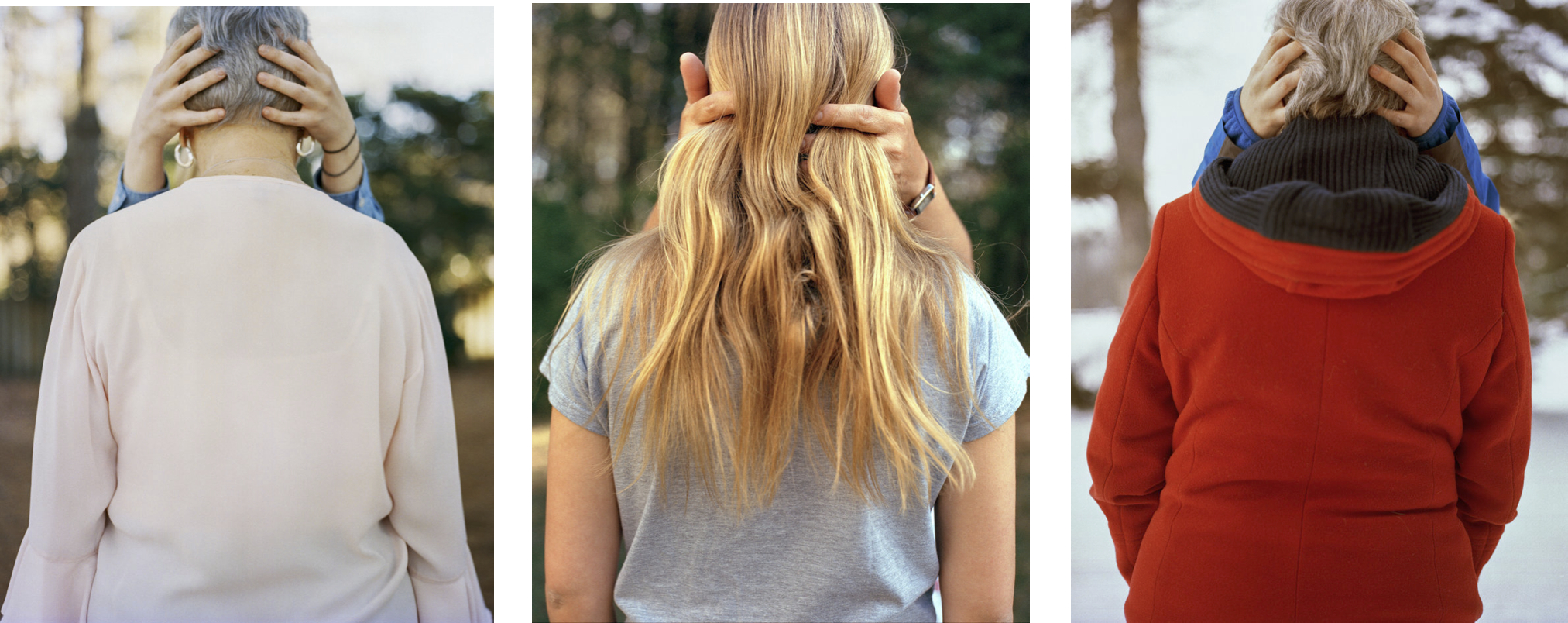By Arlette Hernandez, Recent Yellow House Fellow
Art can be a powerful vehicle toward understanding our pain, our past, and our selves. This belief is central to the work of Yellow House and our partners at the 5 & Dime Theatre Company.
Although we are currenlty showing works by Deja Echols and Robin Kunkel to support the Al Letson play The Center Cannot Hold, we wanted to take a moment to reflect back on the exhibition of Ellen Kanzinger’s series of photographs entitled Affecte(ed) that tied in with the production of Falsettos at the 5 & Dime. Blending interviews, mementos, and still photographs, Kanzinger documents and revisits an important chapter in her life.
At the age of twelve, Kanzinger’s mother discovered a lump on the side of her neck. After visiting two specialists, the family had confirmation that the lump was a cancerous tumor and Kanzinger began preparations for surgery.
“I survived with only 28 stitches and the loss of feeling in my right ear. But the physical scars healed much faster than those on the inside. I was sad that my childhood abruptly came to an end, angry that my body had betrayed me, confused about what came next, and always afraid that it might come back one day.”
Ten years later, Kanzinger reached the magic number—that is, the number of years that must pass before cancer is considered to be in complete remission. Through conversations with her family, Kanzinger explores the anxieties her diagnosis left behind. Affect(ed) invites us to walk with the artist as she explores some of her most intimate thoughts and memories.
Yellow House believes in uplifting the artist’s own voice. So we sat down with Ellen Kanzinger to learn more about her artwork and process.
YH: How did you become interested in photography?
EK: I took a photography class my freshman year of high school and it was pretty much love at first sight. I’ve always been a pretty shy person, so I loved the fact that I could communicate ideas and emotions through my photos. It has completely changed the way I view the world. I’m constantly thinking about light, composition, and subject, even when I don’t have a camera in my hands.
YH: What encouraged you to make this series?
EK: I really wanted to challenge myself to step outside of my normal subject matter. I’ve always loved photographing people, so my family is in a lot of my photographs. But in a lot of ways, this series was about me. As someone who prefers to be behind the camera for a reason, I knew I would have to push myself to let the audience into my life. I also wanted to see if I could personally find some closure. The main audience for the project was myself. As I collected the interviews and photographed my family, I found a lot of my fears and anxieties started to fade away. Cancer is something I will always think about because it has had such a huge impact on my life, but I no longer feel this impending sense that my life will be over too soon.
YH: Almost all of your photographs play with light and shadows in really interesting ways. Was there an inspiration behind this?
EK: When I first started this project, I really struggled with how I wanted to photograph my family [and finding] a way that would complement the audio recordings. I was sitting in my living room one day when I noticed [that] the sun coming in through the skylight was highlighting the chair. My dad was the only one I could find in the house so I made him sit down in the chair and photographed the way the light framed his face. From there, I started seeking out pockets of interesting light in the house I grew up in as well as my grandparents’ homes.
YH: Living in the digital age, we sometimes forget about analog formats and their beauty. What was your favorite thing about working with film as you took these portraits?
EK: Film really forces you to slow down as a photographer and treasure each exposure. I know exactly how much each photo costs me between the film, development, and printing. Because I was working with medium format film, I knew framing would be really important. I prefer not to crop my images so I had to think critically about each composition instead of snapping off a few dozen frames and editing it in Lightroom.
YH: One of the most impactful things about this body of work is the way it chooses to emphasize rather than hide vulnerability. How did it feel to be this open with yourself, your family, and your viewers?
EK: It was absolutely terrifying. Before photographing anyone, I conducted interviews with everyone. Those were really tough conversations because I was talking about fears I had barely admitted to myself, let alone said out loud to someone else. I never wanted to be a burden to anyone else so I supressed a lot of the worries I had over the years. It was a huge moment to finally expressed them out loud, to other people I love and trust, when I struggled by myself for so long. Because this series focused on my feelings and my vulnerabilities, I also struggled to have confidence that viewers would be able to connect in any way with my photographs. It’s so personal that I was afraid to judge my work would be to judge me as a person. But ultimately I knew I had to do this series for myself. In the end, that’s all that mattered to me.
YH: Do you have any advice for young artists and photographers?
EK: It may sound cliche, but art is a process that is never finished. We like to think that art is a complete painting, framed and hanging on the wall of a gallery or museum with security guards making sure no one gets too close. But to only appreciate a painting, sculpture, or photograph in its “final” form is to ignore all that the artist gave of themselves up to that point and all the work that has yet to come.
Ellen Kanzinger is a visual journalist working in Charlottesville, VA. Her work combines elements of still images, text, and audio to explore themes of belonging, memory, and the passage of time. To see more of Kanzinger’s work visit her website here.
To learn more about the 5 & Dime, an institution dedicated to revitalizing Jacksonville’s urban core neighborhood, visit their website at http://the5anddime.org/.


